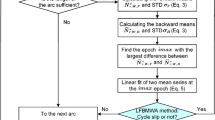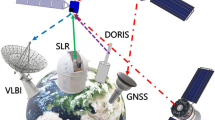Abstract
The short-term variability in receiver code biases (RCBs) has been identified as a prominent source of error leading to the degradation of precise point positioning (PPP) performance and ionospheric total electron content (TEC) estimation accuracy. To minimize the adverse impact of RCB variability, this study extends the modified PPP (MPPP) method from the GPS only dual-frequency (DF) model to multifrequency (MF) and multiconstellation cases. In the MF MPPP method, multi-GNSS (GPS, BDS and Galileo) dual-, triple- or even arbitrary-frequency observations can be jointly processed in a flexible and reliable way by taking the time-varying RCBs of all available signals into account. Benefiting from this, the between-epoch fluctuations experienced by RCBs for all constellations and frequencies can be detected and their adverse impacts on the ionospheric observables and ambiguity parameters are mitigated. Compared to the traditional MF PPP method, the retrieval accuracy of the multi-GNSS-based ionospheric observables using our proposed method can be improved by more than 74% in the presence of significant intraday RCB variations. The variation trends are not always consistent for RCBs in different frequency bands for different satellite systems. The dependence of multi-GNSS and MF RCB variations on the ambient temperature is also verified. The percentages of the stations analyzed with the absolute Pearson correlation coefficient (PCC) values above 0.8 for BDS are higher than those of GPS and Galileo, and the temperature dependence of RCB on the second frequency band is higher than those of the first frequency band for all the three constellations.














Similar content being viewed by others
Data availability
The multi-GNSS observation data and meteorological data from the IGS MGEX networks are available at ftp://cddis.gsfc.nasa.gov/pub/gps/data/daily/. The multi-GNSS observation data and meteorological data from the AUSCORS are available at ftp://ftp.ga.gov.au/geodesy-outgoing/gnss/data/daily/. The multi-GNSS precise ephemeris and satellite clock products from WUM are available at ftp://igs.gnsswhu.cn/pub/gps/products/. The GIM products from IGS can be obtained at ftp://cddis.gsfc.nasa.gov/pub/gps/products/ionex/. CODE’s monthly mean intra-DCB products can be found at ftp.aiub.unibe.ch//CODE/.
References
Al-Shaery A, Zhang S, Rizos C (2012) An enhanced calibration method of GLONASS inter-channel bias for GNSS RTK. GPS Solut 17(2):165–173. https://doi.org/10.1007/s10291-012-0269-5
Benesty J, Chen J, Huang Y (2008) On the importance of the pearson correlation coefficient in noise reduction. IEEE Transactions on Audio Speech & Language Processing 16 (4):757–765. https://doi.org/10.1109/tasl.2008.919072
Brunini C, Azpilicueta FJ (2009) Accuracy assessment of the GPS-based slant total electron content. J Geodesy 83(8):773–785. https://doi.org/10.1007/s00190-008-0296-8
Ciraolo L, Azpilicueta F, Brunini C, Meza A, Radicella SM (2007) Calibration errors on experimental slant total electron content (TEC) determined with GPS. J Geodesy 81(2):111–120. https://doi.org/10.1007/s00190-006-0093-1
Coster A, Williams J, Weatherwax A, Rideout W, Herne D (2013) Accuracy of GPS total electron content: GPS receiver bias temperature dependence. Radio Sci 48(2):190–196. https://doi.org/10.1002/rds.20011
Feess WA, Stephens SG (1987) Evaluation of Gps ionospheric time-delay model. IEEE Trans Aerosp Electron Syst 23(3):332–338. https://doi.org/10.1109/Taes.1987.310830
Feltens J, Angling M, Jackson-Booth N, Jakowski N, Hoque M, Hernandez-Pajares M, Aragon-Angel A, Orus R, Zandbergen R (2011) Comparative testing of four ionospheric models driven with GPS measurements. Radio Sci. https://doi.org/10.1029/2010rs004584
Geng J, Guo J, Chang H, Li X (2018) Toward global instantaneous decimeter-level positioning using tightly coupled multi-constellation and multi-frequency GNSS. J Geodesy 93(7):977–991. https://doi.org/10.1007/s00190-018-1219-y
Håkansson M, Jensen ABO, Horemuz M, Hedling G (2016) Review of code and phase biases in multi-GNSS positioning. GPS Solut 21(3):849–860. https://doi.org/10.1007/s10291-016-0572-7
Hernandez-Pajares M, Roma-Dollase D, Krankowski A, Garcia-Rigo A, Orus-Perez R (2017) Methodology and consistency of slant and vertical assessments for ionospheric electron content models. J Geodesy 91(12):1405–1414. https://doi.org/10.1007/s00190-017-1032-z
Hernández-Pajares M, Lyu H, Garcia-Fernandez M, Orus-Perez R (2020) A new way of improving global ionospheric maps by ionospheric tomography: consistent combination of multi-GNSS and multi-space geodetic dual-frequency measurements gathered from vessel-, LEO- and ground-based receivers. J Geodesy. https://doi.org/10.1007/s00190-020-01397-1
Khodabandeh A, Teunissen PJG (2016) PPP-RTK and inter-system biases: the ISB look-up table as a means to support multi-system PPP-RTK. J Geodesy 90(9):837–851. https://doi.org/10.1007/s00190-016-0914-9
Klobuchar JA (1987) Ionospheric time-delay algorithm for single-frequency Gps users. IEEE Trans Aerosp Electron Syst 23(3):325–331. https://doi.org/10.1109/Taes.1987.310829
Kouba J, Héroux P (2001) Precise point positioning using IGS orbit and clock products. GPS Solut 5(2):12–28. https://doi.org/10.1007/pl00012883
Leick A, Rapoport L, Tatarnikov D (2015) GPS satellite surveying. Wiley, New York
Li XX, Ge MR, Dai XL, Ren XD, Fritsche M, Wickert J, Schuh H (2015) Accuracy and reliability of multi-GNSS real-time precise positioning: GPS, GLONASS, BeiDou, and Galileo. J Geodesy 89(6):607–635. https://doi.org/10.1007/s00190-015-0802-8
Li M, Yuan Y, Wang N, Liu T, Chen Y (2018) Estimation and analysis of the short-term variations of multi-GNSS receiver differential code biases using global ionosphere maps. J Geodesy 92(8):889–903. https://doi.org/10.1007/s00190-017-1101-3
Li B, Zhang Z, Miao W, Ge C (2020a) Improved precise positioning with BDS-3 quad-frequency signals. Satell Navig. https://doi.org/10.1186/s43020-020-00030-y
Li M, Yuan Y, Zhang X, Zha J (2020b) A multi-frequency and multi-GNSS method for the retrieval of the ionospheric TEC and intraday variability of receiver DCBs. J Geodesy. https://doi.org/10.1007/s00190-020-01437-w
Li X, Li X, Jiang Z, Xia C, Shen Z, Wu J (2022) A unified model of GNSS phase/code bias calibration for PPP ambiguity resolution with GPS, BDS, Galileo and GLONASS multi-frequency observations. GPS Solut. https://doi.org/10.1007/s10291-022-01269-5
Liu T, Zhang B, Yuan Y, Zhang X (2019) On the application of the raw-observation-based PPP to global ionosphere VTEC modeling: an advantage demonstration in the multi-frequency and multi-GNSS context. J Geodesy. https://doi.org/10.1007/s00190-019-01332-z
Lou Y, Zheng F, Gu S, Wang C, Guo H, Feng Y (2015) Multi-GNSS precise point positioning with raw single-frequency and dual-frequency measurement models. GPS Solut 20(4):849–862. https://doi.org/10.1007/s10291-015-0495-8
Mikoś M, Kazmierski K, Hadas T, Sośnica K (2023) Multi-GNSS PPP solutions with different handling of system-specific receiver clock parameters and inter-system biases. GPS Solut. https://doi.org/10.1007/s10291-023-01474-w
Montenbruck O, Hauschild A, Steigenberger P (2014a) Differential code bias estimation using multi-GNSS observations and global ionosphere maps. Navigation 61(3):191–201. https://doi.org/10.1002/navi.64
Montenbruck O, Steigenberger P, Hauschild A (2014b) Broadcast versus precise ephemerides: a multi-GNSS perspective. GPS Solut 19(2):321–333. https://doi.org/10.1007/s10291-014-0390-8
Montenbruck O, Steigenberger P, Wang N, Hauschild A (2022) Characterization and performance assessment of BeiDou-2 and BeiDou-3 satellite group delays. Navig J Inst Navig 69(3):526. https://doi.org/10.33012/navi.526
Odijk D, Zhang B, Khodabandeh A, Odolinski R, Teunissen PJG (2015) On the estimability of parameters in undifferenced, uncombined GNSS network and PPP-RTK user models by means of S-system theory. J Geodesy 90(1):15–44. https://doi.org/10.1007/s00190-015-0854-9
Odijk D, Nadarajah N, Zaminpardaz S, Teunissen PJG (2016) GPS, Galileo, QZSS and IRNSS differential ISBs: estimation and application. GPS Solut 21(2):439–450. https://doi.org/10.1007/s10291-016-0536-y
Sardón E, Zarraoa N (1997) Estimation of total electron content using GPS data: How stable are the differential satellite and receiver instrumental biases? Radio Sci 32(5):1899–1910
Shi C, Fan L, Li M, Liu Z, Gu S, Zhong S, Song W (2016) An enhanced algorithm to estimate BDS satellite’s differential code biases. J Geodesy 90(2):161–177. https://doi.org/10.1007/s00190-015-0863-8
Sparks L, Komjathy A, Mannucci AJ (2004) Sudden ionospheric delay decorrelation and its impact on the wide area augmentation system (WAAS). Radio Sci. https://doi.org/10.1029/2002rs002845
Themens DR, Jayachandran PT, Langley RB (2015) The nature of GPS differential receiver bias variability: an examination in the polar cap region. J Geophys Res-Space 120(9):8155–8175. https://doi.org/10.1002/2015ja021639
Wang NB, Yuan YB, Li ZS, Montenbruck O, Tan BF (2016) Determination of differential code biases with multi-GNSS observations. J Geodesy 90(3):209–228. https://doi.org/10.1007/s00190-015-0867-4
Wanninger L, Sumaya H, Beer S (2017) Group delay variations of GPS transmitting and receiving antennas. J Geodesy 91(9):1099–1116. https://doi.org/10.1007/s00190-017-1012-3
Wielgosz P, Grejner-Brzezinska D, Kashani I (2003) Regional ionosphere mapping with kriging and multiquadric methods. J Glob Position Syst 2(1):48–55
Yang Y, Mao Y, Sun B (2020) Basic performance and future developments of BeiDou global navigation satellite system. Satell Navig 1(1):1–8. https://doi.org/10.1186/s43020-019-0006-0
Yuan YB, Ou JK (2004) A generalized trigonometric series function model for determining ionospheric delay. Prog Natl Sci Mater Int 14(11):1010–1014. https://doi.org/10.1080/10020070412331344711
Yuan Y, Wang N, Li Z, Huo X (2019) The BeiDou global broadcast ionospheric delay correction model (BDGIM) and its preliminary performance evaluation results. Navigation 66(1):55–69. https://doi.org/10.1002/navi.292
Zha JP, Zhang BC, Yuan YB, Zhang X, Li M (2019) Use of modified carrier-to-code leveling to analyze temperature dependence of multi-GNSS receiver DCB and to retrieve ionospheric TEC. Gps Solut. https://doi.org/10.1007/s10291-019-0895-2
Zhang BC (2016) Three methods to retrieve slant total electron content measurements from ground-based GPS receivers and performance assessment. Radio Sci 51(7):972–988. https://doi.org/10.1002/2015rs005916
Zhang X, Li P (2015) Benefits of the third frequency signal on cycle slip correction. GPS Solut 20(3):451–460. https://doi.org/10.1007/s10291-015-0456-2
Zhang B, Teunissen PJG, Yuan Y (2016) On the short-term temporal variations of GNSS receiver differential phase biases. J Geodesy 91(5):563–572. https://doi.org/10.1007/s00190-016-0983-9
Zhang BC, Teunissen PJG, Yuan YB, Zhang X, Li M (2018) A modified carrier-to-code leveling method for retrieving ionospheric observables and detecting short-term temporal variability of receiver differential code biases. J Geodesy 93(1):19–28. https://doi.org/10.1007/s00190-018-1135-1
Zhang X, Zhang BC, Yuan YB, Zha JP, Li M (2020a) A refined carrier-to-code levelling method for retrieving ionospheric measurements from dual-frequency GPS data. Meas Sci Technol. https://doi.org/10.1088/1361-6501/ab5267
Zhang Y, Wang H, Chen J, Wang A, Meng L, Wang E (2020b) Calibration and impact of BeiDou satellite-dependent timing group delay bias. Remote Sens 12(1):192. https://doi.org/10.3390/rs12010192
Zhang B, Zhao C, Odolinski R, Liu T (2021) Functional model modification of precise point positioning considering the time-varying code biases of a receiver. Satell Navig. https://doi.org/10.1186/s43020-021-00040-4
Acknowledgements
Many thanks are due to the IGS for providing access to the Multi-GNSS Experiment (MGEX) data, the ionospheric GIM products, and the differential code bias (DCB) products. We also would like to acknowledge the Geosciences Australia for providing access to their data. This work was partially supported by the China Natural Science Funds (No. 42004027), the Hubei International Science and technology cooperation program (No. 2023004), the Open Fund of Hubei Luojia Laboratory (No. 220100061), the State Key Laboratory of Geodesy and Earth’s Dynamics (No.S22L620103). All of this support is gratefully acknowledged.
Author information
Authors and Affiliations
Contributions
ML and JZ initiated the idea and designed the research; ML performed the research and wrote the paper; ML and JZ analyzed the data; XZ also contributed to the data analysis; YY, TL and CZ gave helpful discussions on additional analyses and result interpretation.
Corresponding author
Rights and permissions
Springer Nature or its licensor (e.g. a society or other partner) holds exclusive rights to this article under a publishing agreement with the author(s) or other rightsholder(s); author self-archiving of the accepted manuscript version of this article is solely governed by the terms of such publishing agreement and applicable law.
About this article
Cite this article
Li, M., Zha, J., Yuan, Y. et al. A unified model of multi-GNSS and multi‑frequency precise point positioning for the joint estimation of ionospheric TEC and time-varying receiver code bias. J Geod 98, 12 (2024). https://doi.org/10.1007/s00190-023-01808-z
Received:
Accepted:
Published:
DOI: https://doi.org/10.1007/s00190-023-01808-z




